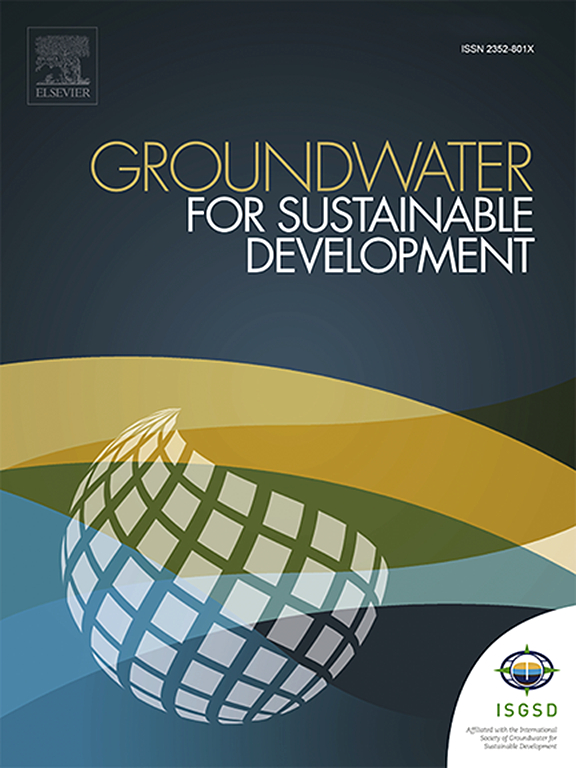确定造成伊朗南部希林鲁德河严重盐碱化的 Romqan 盐化泉的起源、补给和盐度来源
IF 4.9
Q2 ENGINEERING, ENVIRONMENTAL
引用次数: 0
摘要
在伊朗南部半干旱地区,原本是淡水的河流因盐碱泉水而盐碱化,对水资源的可用性构成日益严重的威胁。近年来的持续干旱导致河水流量长期减少,使问题变得更加复杂。这一问题促使人们研究是否有可能通过调查盐碱泉水的补给和盐碱化机制以及涌出时间,找到阻止盐碱泉水流动的实用技术。为此,我们选择了伊朗南部的 Shirinrud 河作为研究案例。虽然这条河含有淡水流量,但由于每年从 Romqan 盐化泉排出的盐分高达 11 万吨,因此盐化程度很高。研究区域的河水流量计、水样以及实地观察和测量均用于提供所需的数据和信息。数据分析包括评估研究区域地下水的温度变化、Shirinrud 河的长期盐度以及水样的同位素和水化学成分。热学、同位素和水化学追踪方法的结果以及罗姆坎泉址的水文地质证据表明,虽然罗姆坎盐泉是从淡水地下水流中补给的,但由于其补给水通道有 1.7 千米的距离在罗姆坎盐沼内流过,因此盐化程度很高。此外,1999 年地震发生后,位于罗姆坎盐沼泽边界的一个淡水泉突然干涸,导致干涸泉水的地下淡水流重新流入罗姆坎盐沼泽,随后在希林鲁德河床出现了罗姆坎盐泉。为阻止 Romqan 盐泉的流动,建议采用截流排水系统,在 Romqan 盐丘边界处分流泉水的新鲜地下水补给流,最终从 Romqan 盐泉中将白林汝德河脱盐。本文章由计算机程序翻译,如有差异,请以英文原文为准。

Identifying the origin, recharge, and salinity sources of the Romqan saline spring, causing intense salinization of the Shirinrud River in southern Iran
Salinization of originally freshwater rivers by saline springs is a growing threat to availability of water resources in the semiarid region of southern Iran. The problem is further complicated by persistent drought of recent years, which has resulted in prolonged periods of reduced streamflow. This issue has prompted research on possibility of finding practical techniques for flow stoppage of saline springs by investigating their recharge and salinization mechanisms as well as emergence time. To this end, the Shirinrud river in southern Iran is selected as a case study. While this river contains freshwater flow, it is intensively salinized due to annual discharge of ∼110000 tons salt from the Romqan saline spring. Study area streamflow gauges, water sampling, plus field observations and measurements have been used to provide the required data and information. Data analyses included evaluation of temperature variations of study area groundwaters, long-term salinity of the Shirinrud River, and isotopic and hydrochemical compositions of water samples. Results of thermal, isotopic, and hydrochemical tracing methods together with hydrogeological evidences in the Romqan spring site indicated that although the Romqan saline spring is recharging from a fresh groundwater flow, it becomes intensely salinized due to passage of ∼1.7 km of its recharging water pass inside the Romqan salt diapir. Furthermore, sudden drying of a freshwater spring at border of Romqan salt diapir just after the 1999 earthquake in spring site area, resulted in redirection of the fresh groundwater flow of the dried spring into the Romqan salt diapir, followed by emergence of the Romqan saline spring in the Shirinrud River bed. For flow stoppage of the Romqan saline spring, an interceptor drainage system is suggested, which would divert the spring fresh recharging groundwater flow at border of Romqan salt diapir and finally desalinize the Shirinrud River from Romqan saline spring.
求助全文
通过发布文献求助,成功后即可免费获取论文全文。
去求助
来源期刊

Groundwater for Sustainable Development
Social Sciences-Geography, Planning and Development
CiteScore
11.50
自引率
10.20%
发文量
152
期刊介绍:
Groundwater for Sustainable Development is directed to different stakeholders and professionals, including government and non-governmental organizations, international funding agencies, universities, public water institutions, public health and other public/private sector professionals, and other relevant institutions. It is aimed at professionals, academics and students in the fields of disciplines such as: groundwater and its connection to surface hydrology and environment, soil sciences, engineering, ecology, microbiology, atmospheric sciences, analytical chemistry, hydro-engineering, water technology, environmental ethics, economics, public health, policy, as well as social sciences, legal disciplines, or any other area connected with water issues. The objectives of this journal are to facilitate: • The improvement of effective and sustainable management of water resources across the globe. • The improvement of human access to groundwater resources in adequate quantity and good quality. • The meeting of the increasing demand for drinking and irrigation water needed for food security to contribute to a social and economically sound human development. • The creation of a global inter- and multidisciplinary platform and forum to improve our understanding of groundwater resources and to advocate their effective and sustainable management and protection against contamination. • Interdisciplinary information exchange and to stimulate scientific research in the fields of groundwater related sciences and social and health sciences required to achieve the United Nations Millennium Development Goals for sustainable development.
 求助内容:
求助内容: 应助结果提醒方式:
应助结果提醒方式:


